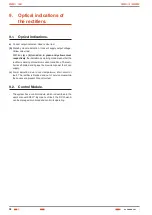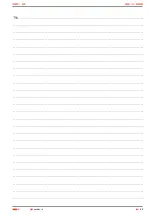
32
•
Battery handling and connection, will be done or su-
pervised by personnel with specific knowledge only.
Before doing any action, disconnect the batteries. Check that
current is not present and there is not dangerous voltage be-
tween both terminal ends of the battery set.
The battery circuit is isolated from the input voltage, in those
equipments with floating output voltage, nevertheless it will
not be, in those equipments with earthed output voltage.
Therefore, dangerous voltages can exist between the termi-
nals of the battery set and earth.
Check the system does not have input voltage before doing
any action over the batteries, otherwise the rectifier will
supply DC voltage to the cables connected to the battery set,
with the consequent risk.
•
Do not forget that a DC Power-S with batteries is a gen-
erator of electrical energy, both batteries are fitted or not
in the own cabinet of the own equipment, so the end-user must
take the needed cautions against direct or indirect contact.
If the batteries are connected to the equipment and their
protection are turned «On», it is irrelevant the fact of having
turned «On» the DC Power-S or not to mains as well as the
position of its protection (On or Off).
The output terminals will supply voltage meanwhile the bat-
tery set has energy, unless the output switch
(F/Q2)
is turned
«Off» or in case of having an outgoing distribution, the gen-
eral protection of the outgoing distribution or each one of
the single protections of the outgoing distribution are turned
«Off».
7.3. To keep in mind.
•
Installation location will be roomy, cooled and with easy ac-
cess. Neither obstruct the cooling grids nor install the equip-
ment outdoors.
•
Input, output and main protective earth cross cable sections
will be in harmony with the nominal current of the nameplate,
being essential requirement to meet the regulations or stand-
ards of the country.
•
A wrong connection or manoeuvring, can cause failures in
the equipment and/or connected loads to it. Read the instruc-
tions of this manual carefully and follow the stated steps in
the established order.
•
In the base of the cabinet there are cable bushing cones
(PR)
, to isolate the connection cable entering from the me-
tallic surface of the cabinet.
Cut them according to the suitable section in order to allow
entering the input, output and battery (systems with separate
battery cabinet only) cables.
Under request some cabinets can have a cable gland plate
(RN) for the cable entry
, instead of the cable bushing cones
(PR)
.
•
All the cables will be fixed with clamps
(AB)
to the rod
(BF)
,
in order to immobilize them and avoid possible yank outs that
could cause false contacts, cable disconnections, ... etc, and
therefore equipment faults and/or possible risk of electrical
discharges.
•
As an example and mere guide for the end-user, figures 5
to 8 show the quantity of «N» rectifier modules connected
in parallel, with the most frequent requested devices and
options. If any of the related parts in the illustrations are not
available in your unit, ignore any reference or act over them.
Whenever it is considered appropriate, additional explana-
tory annexes will be created, for those equipments manufac-
tured under particular requirements.
7.4. Main protective earth terminal or
rod (X5) and/or (X5A).
•
It is advisable and it is forced by the country regulations or
standards, to connect the device to earth.
Make sure that all the loads connected to the equipment are
only connected to the earth bonding terminal (X5). The fact of
not restricting the earthing of the load or loads to this single
point will create backfeed loops to earth that will affect to the
quality of the power supplied.
All the terminals identified as main protective earthing ter-
minal ( ), are joint among them and connected to the
ground of the cabinet.
•
In those models with separate battery cabinet, joint the main
protective earth terminal or rod
(X5) of the
rectifier, with the
earth bonding terminal
(X5A)
of the battery cabinet
( )
, by
using the foreseen cable in the battery cable bundle.
•
DC Power-S can be supplied from factory with the positive
pole connected to earth, negative to earth or floating. In the
nameplate and in the terminal labelling, it is identified the con-
nection type by means of the sign «+» or «–», written down
before the output voltage figure, which will indicate the alive
pole.
It is very important to assure that the loads that are being con-
nected to the equipment have the same type of connection of
itself, otherwise it will mean a risk for the personnel and the
destruction of the installation and annexes equipments.
By default and if it is not stated, all the equipments are sup-
plied with floating output voltage.
•
It is recommended to use shielded cables for commu-
nications, as well as the connection of the own shield
to earth through the terminal or rod
(X5)
.
7.5. Connection of the system with the
battery set or cabinet. Terminals
(X11) - (X12) and (X47) - (X48).
•
This operation is only destined to connect the battery termi-
nals of the system with the respective of the battery cabinet/s,
although the batteries belong to the client or they are sup-
plied together with the equipment.
Any instructions referred to the physical fitting of each cell in
the cabinet of the system or battery, is described in section
7.2.
•
All protections or switches of the system has to be in «Off»
position, and in particular the one belonging to batteries in
the equipment
(F/Q3) and its homologous
(F/Q8) in the
battery cabinet
, in case there were an external battery set.
As the fuses are supplied inserted in the fuse holder,
to avoid misleading and losses, it is important to check
that the switches are opened (Off).
USER MANUAL
Summary of Contents for DC POWER-S DC-10-S
Page 2: ......
Page 18: ...18 Case with casters dimensions Cabinet dimensions 605x605x1315 mm 605x805x1315 mm USER MANUAL...
Page 42: ...42 USER MANUAL...
Page 43: ...43 SALICRU...



























